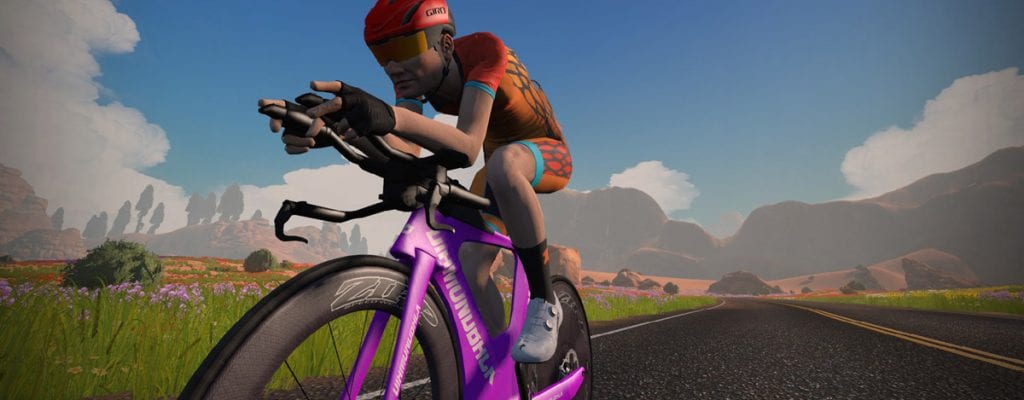Any cyclist worth their chamois knows that body weight is a huge performance factor for riders. The more mass you have to move, the more power you have to put out to move it!
And this is true no matter what road you may ride. Sure, weight matters the most on climbs. But it’s also a factor on flats and descents.
We decided to do some testing to see just how much each kilogram of weight slows (or speeds) a rider on Zwift. Our tests included flat roads, climbs, and descents. And they answer that eternal question: should you work to lose weight, or invest your money (Drops) in a faster virtual ride?
We found the results quite interesting, and we think you will, too.
A few notes about our tests:
- All tests used a 183cm (6′) tall rider riding at 300 watts on the Zwift Aero frame with Zwift 32mm carbon wheels.
- We ran each test at two different rider weights: 75kg and 82kg. We went with a 7kg difference because Zwift HQ says this is the weight difference between Zwift’s lightest and heaviest bikes. So the speed differences you see below could be realized purely through equipment changes in game!
- Riding at higher or lower wattage or being significantly heavier or lighter than our test riders would impact time gaps somewhat, but we choose to keep the tests simple so the results would be easy to understand.

Effect of Rider Weight on Climbs
Climbing tests were completed up Alpe du Zwift, an 8.5% average gradient which is 12.2km long.
Test Results
- 82kg @ 300 watts: 54 minutes, 49 seconds (13.4kph)
- 75kg @ 300 watts: 49 minutes, 31 seconds (14.8kph) – 318 seconds faster
Climb Test Observations
Not surprisingly, up the steep Alpe climb is where we can really see how much weight affects rider speed. The time gap here is over 6x what we see on the flats! This is why lightweight riders win mountain races outdoors while the heavier sprinters struggle to finish within the time cutoff.
Conclusion: reducing your body weight by 1kg will save you ~45 seconds up Alpe du Zwift.

Effect of Rider Weight on Flat Roads
Flat tests were completed over two laps of the Tempus Fugit route.
Test Results
- 82kg @ 300 watts: 52 minutes, 17 seconds (39.7kph)
- 75kg @ 300 watts: 51 minutes, 26 seconds (40.4kph) – 51 seconds faster
Flat Test Observations
While some Zwifters like to say “it’s all about pure watts on flat roads,” it’s not that simple. Weight does affect your speed on the flats in Zwift, since it changes your computed CdA. Or to put it another way: two riders of the same height but different weights will have different CdA values in Zwift, meaning the heavier rider will need to push more watts to keep up with the lighter rider, who is encountering less (virtual) air resistance.
Conclusion: reducing your body weight by 1kg will save you ~9 seconds over an hour-long flat race effort on Zwift.

Effect of Rider Weight on Descents
Descent tests were completed down Alpe du Zwift, an -8.5% average gradient which is 12.2km long.
Test Results
- 75kg @ 300 watts: 10 minutes, 7 seconds (72.5kph)
- 82kg @ 300 watts : 10 minutes flat (73.3kph) – 7 seconds faster
Descent Test Observations
Riders complain about getting dropped on descents in Zwift, but that isn’t because the algorithm is computing speed incorrectly. The real reason riders get dropped on Zwift descents is that the pack keeps pedaling on the downhills. If you aren’t putting out power on a downhill in a race, you’ll get dropped–no matter what you weigh. Unless you supertuck smartly.
Conclusion: reducing your body weight by 1kg will cost you 1 second on a 10-minute Alpe du Zwift descent.
Buying Upgrades, Riding Up Grades
The great Eddy Merckx famously said, “Don’t buy upgrades, ride up grades.” He was making the point that, if you want to be a better rider, training is the way forward. Buying more expensive equipment will get you marginal gains, but increasing your power and/or reducing your weight will get you greater gains, without impacting your bank account!
Our test results above coupled with hundreds of additional test laps show an notable “2kg line” in Zwift performance on flat roads:
- The difference between the fastest frame + wheel combo and a basic racing setup (Zwift Aero frame with Zipp 808 wheels) is 18 seconds over an hour ride. This is roughly the same time improvement you would see by dropping 2kg of body weight.
If you’re carrying a few extra pounds and find yourself concerned about your Zwift race bike setup being a bit slow–see if you can shed some weight. Dropping just 2kg (4.4 pounds) will have the same effect as upgrading your basic Zwift ride to a top of the line racer, assuming you’re able to maintain the same power.
There is also a “1kg line” for Zwift performance on steep climbs like the Alpe:
- The difference between the fastest frame/wheel setup on climbs and a basic racing setup (Zwift Aero frame with Zipp 808 wheels) is 52 seconds over an hour climb. This is roughly the same time improvement you would see from dropping 1kg of body weight.
If you still haven’t unlocked the Lightweight Meilenstein wheels atop the Alpe, there’s a way to make up for it: losing just 1kg will save you more time than those wheels ever could. Time to start counting calories, perhaps?
An Important Note
If you’re overweight, losing those unhealthy pounds can improve your cycling performance both on Zwift and outdoors. But any attempts at weight loss should be handled carefully, and ideally under the watchful care of a qualified professional.
In a competitive, weight-based, results-driven environment like bike racing it’s easy to go too far and actually damage your body with extreme dieting or disordered eating.
Read “RED-S: One Athlete’s Story” for more on this topic.
Your Thoughts
Inspired to shed a few pounds? Surprised by the results above? Share any questions or comments below!
Note: This is a simplified version of the original post. The first version was revised after it generated a lot of confusion that distracted from the goal of learning “how much faster you’ll be if you lose 1kg of weight.”
